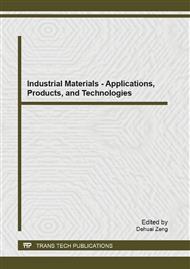[1]
G. Mihalakakou, M. Santamouris, D. Asimakopoulos and I. Tselepidaki: Parametric prediction of the buried pipes cooling potential for passive cooling applications. Solar Energy, Vol. 55 (1995), p.163.
DOI: 10.1016/0038-092x(95)00045-s
Google Scholar
[2]
P. Hollmuller and B. Lachal: Cooling and preheating with buried pipe systems: monitoring, simulation and economic aspects. Energy and Buildings, Vol. 33 (2001), p.509.
DOI: 10.1016/s0378-7788(00)00105-5
Google Scholar
[3]
C.E. Francis: Earth cooling tubes – case studies of three Midwest installations. Proceedings of the international passive cooling conference, Miami, Florida (1981), p.171.
Google Scholar
[4]
T.M. Akridge and CC. Benton: Performance studies of a thermal envelope house. Phase II—cooling performance. Atlanta, Georgia: Southern Solar Energy Center (1981).
DOI: 10.2172/5294611
Google Scholar
[5]
B. K . Shingarie et al: Earth tube heat exchanger. Poultry International (1995) p.92.
Google Scholar
[6]
J.M. Akridge. Investigation of passive cooling techniques for hot humid climates. Research report, College of Architecture, Georgia Institute of Technology, Atlanta, Georgia (1982).
DOI: 10.2172/5438959
Google Scholar
[7]
M. Bojic, N. Trifunovic, G. Papadakis and S. Kyritsis: Numerical simulation, technical and economic evaluation of air-to-earth heat exchanger coupled to a building, Solar Energy, Vol. 22 (1997), p.1151.
DOI: 10.1016/s0360-5442(97)00055-8
Google Scholar
[8]
F. Al-Ajmi, D.L. Loveday and V.I. Hanby: The cooling potential of earth–air heat exchangers for domestic buildings in a desert climate. Building and Environment, Vol. 41 (2006), p.235.
DOI: 10.1016/j.buildenv.2005.01.027
Google Scholar
[9]
A.S. Dhaliwal and D.Y. Goswami: Heat transfer analysis environment control using an underground air tunnel. ASME Solar Energy Div., Las Vegas, (1984). p.505.
Google Scholar
[10]
S. Thiers and B. Peuportier: Thermal and environmental assessment of a passive building equipped with an earth-to-air heat exchanger in France. Solar Energy; Vol. 82 (2008), p.820.
DOI: 10.1016/j.solener.2008.02.014
Google Scholar
[11]
Solar Energy Laboratory: TRNSYS user manual. University of Wisconsin-Madison (1996).
Google Scholar
[12]
K.H. Lee and R.K. Strand: The cooling and heating potential of an earth tube system in buildings. Energy and Buildings; Vol. 40 (2008) p.486.
DOI: 10.1016/j.enbuild.2007.04.003
Google Scholar
[13]
J. Pfafferott: Evaluation of earth-to-air heat exchangers with a standardized method to calculate energy efficiency. Energy and Buildings; Vol. 35 (2003) p.971.
DOI: 10.1016/s0378-7788(03)00055-0
Google Scholar
[14]
M.K. Ghosal, G.N. Tiwari, Modelling and parametric studies for thermal performance of an earth to air heat exchanger integrated with a greenhouse, Energy Convers. Manage. (2006) p.1779.
DOI: 10.1016/j.enconman.2005.10.001
Google Scholar


